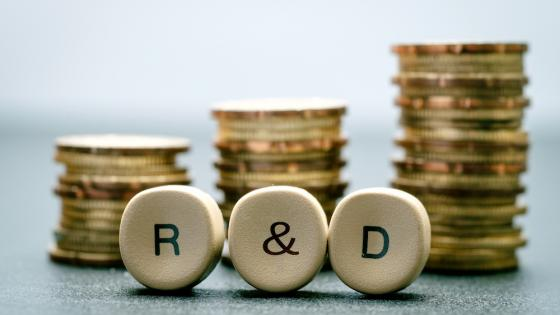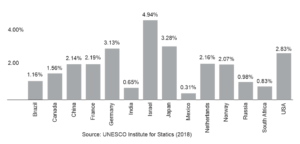
India’s R&D spends amongst the lowest in the world: NITI Aayog study
- November 15, 2022
- 0
India’s spending on research and development (R&D) is among the lowest in the world, as per a study conducted by government think-tank NITI Aayog and Institute for Competitiveness.
R&D investment in India, in fact, has declined from 0.8% of the GDP in 2008-09 to 0.7% in 2017-18.
Data show that India’s GERD is lower than the other BRICS nations. Brazil, Russia, China and South Africa Spend around 1.2%, 1.1%, above 2% and 0.8% respectively. The world average is around 1.8%.
The India Innovation Index 2021 has found that the overall spending on R&D by India has been relatively low across the country. This was reflected in the overall share of gross expenditure on R&D (GERD) as a percentage of GDP, at about 0.7%.
Developed countries the United States, Sweden, and Switzerland spend about 2.9%, 3.2% and 3.4%, respectively. Israel spends 4.5% of its GDP on R&D, the highest in the world.
In 2008, China was spending about 35% less than the US on research and development (R&D) and half that of Europe. It overtook Europe in 2014. In 2020, its expenditure was 85 percent compared to America.
A Harvard University report concludes that China is a serious competitor in the basic technology of the 21st century. Therefore, other western countries including America have started fast to maintain their edge in technology.
Investment in technology is booming around the world.
Among the reasons cited for the low spending on R&D in developing countries like India is that investments in R&D take time to produce results. Countries like India tend have bigger issues like hunger, disease control, and raising the quality of life and authorities divert resources towards tackling them.
“However, it can be argued that these pressing concerns shouldn’t be viewed as a hindrance, but rather an opportunity to widen the ambit of R&D,” the study says.
Data shows that countries that spend less on GERD fail to retain their human capital in the long run.”
Lower spending on R&D, and less innovation opportunities may lead people to move from one region to another region-state/country for better opportunity. This phenomenon is known as brain drain and reduces the competitive edge of a state, further impacting the country’s overall economy,” the study says.
GERD as a percentage of GDP Countries with higher per capita GDP invest more in R&D
R&D as a % of GDP

For India to achieve its goal of a $5 trillion economy, India’s GERD needs considerable improvement and needs to touch at least 2% “With such low contribution, R&D performance remains stagnant,” the report said.
Many companies, experts and even the RBI, over the years, have flagged the poor performance when it comes to R&D. It has also been observed that there is a mismatch between what is taught at the university level and what is required at the industrial level, the study says.
Most recently, Infosys co-founder Kris Gopalakrishnan had asserted the need for higher spending on R&D, with more contribution from private companies and institutions.
“We need to invest more money in research. Research spending should hit 3% of (India’s) GDP from 0.7% currently. OF this private contribution should jump at least 1.5% from 0.1% at present,” said Gopalakrishnan.
भारत का R&D दुनिया में सबसे कम खर्च करता हैः
नीति आयोग का अध्ययन
सरकारी थिंक-टैंक नीति आयोग और इंस्टीट्यूट फॉर कॉम्पिटिटिवनेस द्वारा किए गए एक अध्ययन के अनुसार, अनुसंधान और विकास (R&D) पर भारत का खर्च दुनिया में सबसे कम करने वालों में है।
भारत में अनुसंधान एवं विकास निवेश, वास्तव में, 2008-09 में सकल घरेलू उत्पाद के 0.8 प्रतिशत से घटकर 2017-18 में 0.7 प्रतिशत हो गया है।
आंकड़े बताते हैं कि भारत का जीईआरडी अन्य ब्रिक्स देशों की तुलना में कम है। ब्राजील, रूस, चीन और दक्षिण अफ्रीका क्रमशः 1.2 प्रतिशत, 1.1 प्रतिशत, 2 प्रतिशत से अधिक और 0.8 प्रतिशत खर्च करते हैं। विश्व औसत लगभग 1.8 प्रतिशत है।
इंडिया इनोवेशन इंडेक्स 2021 में पाया गया है कि भारत द्वारा R&D पर कुल खर्च देश भर में अपेक्षाकृत कम रहा है। यह जीडीपी के प्रतिशत के रूप में R&D (जीईआरडी) पर सकल व्यय के कुल हिस्से में लगभग 0.7 प्रतिशत परिलक्षित होता था।
विकसित देश संयुक्त राज्य अमेरिका, स्वीडन और स्विटजरलैंड क्रमशः 2.9 प्रतिशत, 3.2 प्रतिशत और 3.4 प्रतिशत खर्च करते हैं। इज़राइल अपने सकल घरेलू उत्पाद का 4.5 प्रतिशत R&D पर खर्च करता है, जो दुनिया में सबसे अधिक है।
2008 में, चीन अनुसंधान और विकास (R&D ) पर अमेरिका की तुलना में लगभग 35 प्रतिशत कम और यूरोप का आधा खर्च कर रहा था। 2014 में इसने यूरोप को पीछे छोड़ दिया। 2020 में इसका खर्च अमेरिका के मुकाबले 85 फीसदी था।
हार्वर्ड यूनिवर्सिटी की एक रिपोर्ट का निष्कर्ष है कि चीन 21वीं सदी की बुनियादी तकनीक में एक गंभीर प्रतियोगी है। इसलिए अमेरिका समेत अन्य पश्चिमी देशों ने टेक्नोलॉजी में अपनी बढ़त बनाए रखने के लिए तेजी से शुरुआत की है। दुनिया भर में प्रौद्योगिकी में निवेश फलफूल रहा है।
भारत जैसे विकासशील देशों में R&D पर कम खर्च के लिए उद्धृत कारणों में यह है कि R&D में निवेश के परिणाम देने में समय लगता है। भारत जैसे देशों में भूख, रोग नियंत्रण, और जीवन की गुणवत्ता बढ़ाने जैसे बड़े मुद्दे हैं और अधिकारियों ने उनसे निपटने के लिए संसाधनों का इस्तेमाल किया है।
अध्ययन में कहा गया है,‘‘हालांकि, यह तर्क दिया जा सकता है कि इन दबाव वाली चिंताओं को एक बाधा के रूप में नहीं देखा जाना चाहिए, बल्कि अनुसंधान एवं विकास के दायरे को व्यापक बनाने के अवसर के रूप में देखा जाना चाहिए।”
डेटा से पता चलता है कि जीईआरडी पर कम खर्च करने वाले देश लंबे समय में अपनी मानव पूंजी को बनाए रखने में विफल रहते हैं।”
R&D पर कम खर्च, और कम नवाचार के अवसर लोगों को बेहतर अवसर के लिए एक क्षेत्र से दूसरे क्षेत्र-राज्य/देश में स्थानांतरित करने के लिए प्रेरित कर सकते हैं। इस घटना को ब्रेन ड्रेन के रूप में जाना जाता है और एक राज्य की प्रतिस्पर्धात्मक बढ़त को कम करता है, जो देश की समग्र अर्थव्यवस्था को और प्रभावित करता है, ”अध्ययन में कहा गया है।
जीडीपी के प्रतिशत के रूप में जीईआरडी उच्च प्रति व्यक्ति सकल घरेलू उत्पाद वाले देश अनुसंधान एवं विकास में अधिक निवेश करते हैं
जीडीपी के प्रतिशत के रूप में R&D
भारत को 5 ट्रिलियन डॉलर की अर्थव्यवस्था के अपने लक्ष्य को प्राप्त करने के लिए, भारत के R&D में काफी सुधार की आवश्यकता है और कम से कम 2 प्रतिशत को छूने की जरूरत है।
रिपोर्ट में कहा गया है, ‘‘इतने कम योगदान के साथ, R&D का प्रदर्शन स्थिर बना हुआ है।”
कई कंपनियों, विशेषज्ञों और यहां तक कि आरबीआई ने भी पिछले कुछ वर्षों में R&D के मामले में खराब प्रदर्शन की बात कही है। अध्ययन में कहा गया है कि यह भी देखा गया है कि विश्वविद्यालय स्तर पर जो पढ़ाया जाता है और औद्योगिक स्तर पर क्या आवश्यक है, के बीच एक बेमेल है।
हाल ही में, इंफोसिस के सह-संस्थापक क्रिस गोपालकृष्णन ने निजी कंपनियों और संस्थानों के अधिक योगदान के साथ, R&D पर अधिक खर्च की आवश्यकता पर जोर दिया था।
उन्होंने कहा, ‘‘हमें शोध में और पैसा लगाने की जरूरत है। अनुसंधान खर्च वर्तमान में 0.7 प्रतिशत से (भारत के) सकल घरेलू उत्पाद का 3 प्रतिशत हिट होना चाहिए। इस निजी योगदान में वर्तमान में 0.1 प्रतिशत से कम से कम 1.5 प्रतिशत की वृद्धि होनी चाहिए,” गोपालकृष्णन ने कहा।
































































